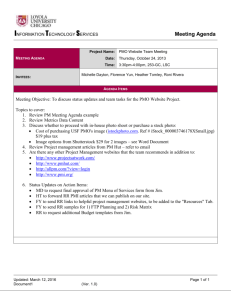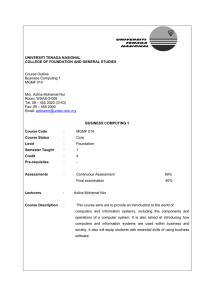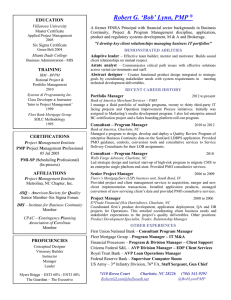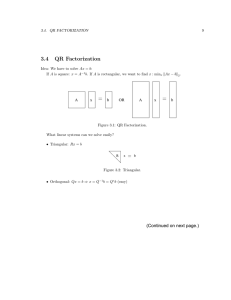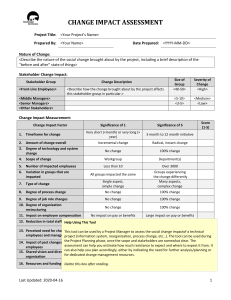Categorisation of Designs According to Preference Values for Shape Rules
advertisement
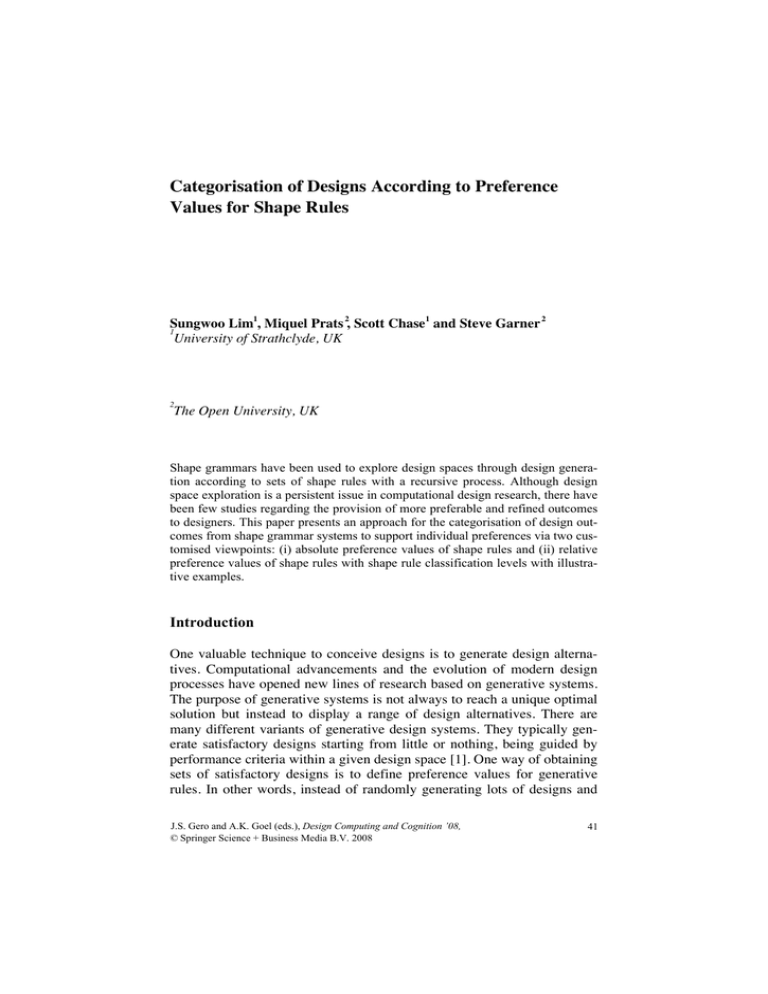
Categorisation of Designs According to Preference
Values for Shape Rules
Sungwoo Lim1, Miquel Prats 2, Scott Chase1 and Steve Garner 2
1
University of Strathclyde, UK
2
The Open University, UK
Shape grammars have been used to explore design spaces through design generation according to sets of shape rules with a recursive process. Although design
space exploration is a persistent issue in computational design research, there have
been few studies regarding the provision of more preferable and refined outcomes
to designers. This paper presents an approach for the categorisation of design outcomes from shape grammar systems to support individual preferences via two customised viewpoints: (i) absolute preference values of shape rules and (ii) relative
preference values of shape rules with shape rule classification levels with illustrative examples.
Introduction
One valuable technique to conceive designs is to generate design alternatives. Computational advancements and the evolution of modern design
processes have opened new lines of research based on generative systems.
The purpose of generative systems is not always to reach a unique optimal
solution but instead to display a range of design alternatives. There are
many different variants of generative design systems. They typically generate satisfactory designs starting from little or nothing, being guided by
performance criteria within a given design space [1]. One way of obtaining
sets of satisfactory designs is to define preference values for generative
rules. In other words, instead of randomly generating lots of designs and
J.S. Gero and A.K. Goel (eds.), Design Computing and Cognition ’08,
© Springer Science + Business Media B.V. 2008
41
42
S. Lim et al.
then looking for meaningful solutions, it is sometimes more reasonable to
define rules that generate only sequences of designs that are accord with
designer preferences.
Shape grammars [2] are production systems that generate designs according to sets of shape rules. These rules are of the form
, where a
and b are both labelled shapes, and are applicable to a shape S if there is a
transformation that imbeds a in S. A shape rule is applied by replacing the
transformed shape a in S with the similarly transformed shape b. These allow the construction of complex shapes from simple shape elements. The
potential for applying shape grammars to explore design spaces has been
applied in areas such as architectural and consumer product design [3].
Despite a history going back decades [4], progress in computer implementation of shape grammar systems has been slow [5]. This is partly due to
complexities in object representation used in such systems [6] but is also
possibly a consequence of the characteristic of producing large, possibly
an infinite number of outcomes [7]. As a result relatively few researchers
have attempted to categorise outcomes from shape grammar systems.
While diversity and number of outcomes may be appreciated by designers,
they may wish to limit this number in order to reduce their efforts to find
preferable (or appropriate) ones.
The research described here results from an ongoing project concerning
design synthesis and shape generation (DSSG). The project explores how
designers generate shapes and how shape computation systems might support designers without impinging upon their creativity. The aim of this paper is to present an approach to categorising design outcomes from shape
grammar systems to support individual preference. It offers the possibility
of providing more preferable and refined outcomes to designers based on
their own ways of shape generation. Here, the categorisation of design outcomes is not intended to reflect a measure of similarity or style but instead
is intended to reflect the likelihood that designs would be produced by a
designer. This likelihood is based on experimental data concerned with
analysing how designers specify and manipulate shapes when exploring
designs [8]. This analysis led to the definition of shape rules believed to
capture the manipulations typically used by designers, and to data related
to the frequency that such rules were used to explore designs.
Clustering via customisable viewpoints
Shape rules can formalise the creative process that involves the generation
of designs, the selection of the preferable, and the seeding of a new genera-
Categorisation According to Preference Values for Shape Rules
43
tion, until a competent design is found or the entire design space has been
explored [9]. This process, however, may not be ideal for design exploration since design spaces tend to be immense and the probability of obtaining a satisfactory design in a reasonable length of time is very small.
One possible way to customise design outcomes is by categorisation according to the similarity of shape characteristics. Clusters of designs may
be organised into a hierarchical structure where they are broken down into
subclusters [10]. In this case, a hierarchical classifier is needed to divide
the classes into contextual subgroups, which are then further divided to
produce a tree structure defining relationships between classes [11]. A
number of methods are extant for hierarchical clustering depending on the
area of application, e.g. in biological taxonomy, psychology and cognitive
science [12], physics [13], and artificial intelligence [14].
Some investigations have been conducted into multiple viewpoints for
clustering. Researchers have found that different results can be obtained
when the same data set is analysed using a different clustering strategy
during computational clustering [15, 16]. For example, Howard-Jones [17]
carried out an experiment in which subjects looked at a geometrical shape,
generating as many interpretations of the shape as possible based on different viewpoints. Duffy and Kerr [18] suggest that designers require different viewpoints from past designs and abstractions in order to facilitate
the effective utilisation of past design knowledge, and pointed out the need
to support different viewpoints, termed ‘Customised Viewpoints’ (CV).
Manfaat and Duffy [19] extended this theory to support the effective utilisation of spatial layouts for ship design by hierarchical levels of abstractions according to designers’ needs. To maximise the capability of CV, the
selection of criteria for clustering that are appropriate to the data being investigated is crucial [20].
Due to the characteristics of Shape Grammar systems, which potentially
produce large numbers of outcomes [7], categorising design outcomes
could facilitate more widespread use of this design paradigm. As the main
aim of CV is to classify designs via different viewpoints, adapting the concept of CV could provide a way of categorising and refining outcomes by
individual viewpoints and preferences.
Preference values and classification of shape rules
Understanding designers’ preferences when interacting with shapes is
needed to utilise CV with shape grammars. As a part of the DSSG project,
a sketch observation experiment [8] to identify shape rules in shape trans-
44
S. Lim et al.
formation was undertaken. Six architects and eight product designers with
various ranges of professional experience were involved in the experiment.
They responded to a series of conceptual design tasks and produced an
output of nearly 300 sketches. Entire sketching activities and sketch
strokes were recorded to analyse shape transformation using three criteria—Decomposition, Reinterpretation and Design family—which were applied to three tasks consisting of short design briefs and initial design
stimuli.
Shape rules from the experiment
As a result of our preliminary experiment, 7 general shape rules (Table 1)
and 14 detailed shape rules (Table 2) were identified. These can be regarded as the personal rules of the participants. The hierarchical classification was suggested due to the similarities among shape rules. Note that the
outline transformation rule in Table 1 denotes ‘changing outline shape including stretching and contour manipulation’ while the structure transformation rule indicates ‘changing shape position including rotation, translation and symmetry’.
Table 1 General shape rules identified
Table 2 Detail shape rules identified
Shape rules in a higher (general) level could contain a number of detailed rules in their lower levels (Figure 1). From our experiment, the outline transformation rule comprises a number of similar shape rules i.e.,
bend, straighten, change length/width and change angles, while the structure transformation rule includes flip/mirror, change shape direction, split
Categorisation According to Preference Values for Shape Rules
45
shape, and change shape position rules. The bend rule in the detailed
shape rules denotes ‘giving curvature to a shape’, while the straighten rule
indicates the opposite meaning; the change angles rule indicates ‘changing
an interior angle of a shape’; and the combine shapes rule means ‘adding
and merging a new shape to an existing shape’, while the add rule adds a
new shape without merging them. Indeed, classification of these shape
rules can be further refined; for example, the bend rule can produce different types of curvature to a shape captured in shape rules (e.g. soft radius,
sharp radius, a curve with rising curvature and so on).
Replacement
rule
LEVEL-1
LEVEL-2
Outline (R1)
Bend (R11)
Straighten (R12)
Change length/width (R13)
Change angles (R14)
Structure (R2)
Flip/Mirror (R21)
Change shape direction (R22)
Split shape (R23)
Change shape position (R24)
Combine shapes (R25)
Substitute (R3)
Substitute (R3)
Add (R4)
Add (R4)
Delete (R5)
Delete (R5)
Cut (R6)
Cut (R6)
Change view (R7)
Change view (R7)
Fig. 1. Hierarchical classification of the identified shape rules
In addition to providing an objective means of analysis, these rules provide a means for formally generating design alternatives. Note that the
graphical representations of these rules express shape transformations in an
abstract way and are not meant to represent the exact transformation of a
shape, meaning that the same rule may be applied to different shapes and
transform them in different ways. For example, the first (R12) and third
46
S. Lim et al.
(R12) rules for the design outcome S01 in the Appendix are the same abstract rule—straighten—but are applied under different shape transformations. In addition, this list of rules is not by any means complete; they
were, however, sufficient to capture participants’ shape transformations.
The identified shape rules are then hierarchically classified, and the rules
R3 to R7 are directly applied to level-2 because they do not have child rules
(Figure 1).
Preference values of shape rules
Some rules were used by participants significantly more than others, e.g.
change shape length/width (R12), change view (R7), add (R4), and
straighten (R12) were used 2 to 10 times more than others (Table 3). This
result suggests that it may be possible to (i) identify priorities of shape
rules, (ii) calculate the preference values for each shape rule based on the
frequency of rule use and (iii) use the preference values as speculative
tools to provide customisable categorisations of design outcomes. The preference value was calculated by normalisation between 0.0 and 1.0 based
on the sum of total use for each rule from the experiment’s results (see the
last column in Table 3), and the value can be incrementally updated whenever new results from experimentation are added. For example, use of the
substitute rule was hardly observed in our experiment; thus the preference
value is considered as 0.0. It can be, however, changed depending on the
result of additional experiments.
Table 3 The use of the shape rules in architectural design. The numbers in each
task indicate the frequency of rule use and the number of participants who used
the rule (in parentheses)
Rank Shape Rules
Task 1 Task 2 Task 3
Total
use of
the rule
Preference
value
(normalised)
1
Change length/width (R13)
35 (6)
9 (4)
11 (3)
55
0.239130
2
Change view (R7)
0 (0)
22 (6)
21 (5)
43
0.186957
3
Add (R4)
18 (4)
8 (3)
7 (3)
33
0.143478
4
Straighten (R12)
22 (6)
0 (0)
2 (2)
24
0.104348
5
Change shape position (R24)
13 (5)
0 (0)
1 (1)
14
0.060870
6
Bend (R11)
9 (2)
0 (0)
2 (2)
11
0.047826
7
Delete (R5)
10 (2)
1 (1)
0 (0)
11
0.047826
8
Change shape direction (R22)
10 (5)
0 (0)
0 (0)
10
0.043478
9
Combine shapes (R25)
5 (3)
4 (3)
0 (0)
9
0.039130
Categorisation According to Preference Values for Shape Rules
10
0 (0)
8 (2)
8
47
Split shape (R23)
0 (0)
0.034783
11
Change angles (R14)
5 (2)
1 (1)
0 (0)
6
0.026087
12
Flip/Mirror (R21)
3 (2)
2 (1)
0 (0)
5
0.021739
13
Cut (R6)
0 (0)
0 (0)
1(1)
1
0.004348
14
Substitute (R3)
0 (0)
0 (0)
0 (0)
0
0.0
Formalisation of customised viewpoints
Design outcomes can be categorised differently depending on customised
viewpoints. For example, shapes S1 and S2, which are generated by a number of shape rules with a sequential manner, e.g. {S1|Ra,Rb,Ra,Rd} and
{S2|Ra,Rc,Re} (Figure 2), can be in the same cluster if the shape rule Ra is a
most important criterion, while they could be classified in a different cluster in other cases.
(a)
(b)
Fig. 2. Example shapes S1 and S2 with respective rule sequences
Here an experimental approach to categorising outcomes is presented
which calculates and sorts a preference value for each outcome. The preference value P for each outcome is normalised between 0.0 and 1.0, and
can be obtained via two customised viewpoints: (i) absolute P by the frequency of shape rule use; (ii) relative P by shape rule classification level.
To calculate the above P for each outcome, a number of criteria need to be
predefined: (i) a hierarchical (multi-level) classification of shape rules
(Figure 1); (ii) a weight value Qm for each step of a shape rule sequence;
(iii) a preference value
for each shape rule Rn (see the last column in
Table 3). For now, each Qm is equally distributed depending on the maxi-
48
S. Lim et al.
mum number of sequence steps from a design outcome, i.e.
where
L is the maximum number of sequence steps. The distribution of Qm, however, could be adjusted in future research, e.g. the first and last step of a
sequence could have more weight if we consider those to be more effective
for outcomes than others. The details of the formalisation of P by each
viewpoint are described in the following sections.
Customised viewpoints by absolute preference values
According to our experimental data [8], designers respond positively to
specific rules which can affect the types of design outcomes. In this paper,
design outcomes are categorised based on the preference value of shape
rules because a preference value offers one way of representing a personal
design intention. An absolute P1 for the above shape S1, which is generated
by a four step rule sequence, i.e. {S1|Ra,Rb,Ra,Rd}, is calculated by all the
rule values with respective sequential weights. This value can be used to
determine the order of outcomes without any classifications, so designers
could limit the number of preferable outcomes from the entire set of possible outcomes. Considering the sequence of rule application for the shape
S1, the absolute P1 is calculated as
(1)
Because Qm is equally distributed here, the absolute P1 is the same as the
sum of
divided by the sequence length, and can be summarised as
(2)
Thus, a general shape S1 can be calculated as below when Vi is the sum
of the preference values of used shape rules for shape S1:
(3)
Customised viewpoints by relative preference values with a rule
classification level
Sometimes designers may wish to limit outcomes by the generality of
shapes [18, 19]. In this case, setting the outcome criteria by classification
levels of shape rules would be useful because a higher classification level
Categorisation According to Preference Values for Shape Rules
49
of shape rules allows a broad range of shape types while a lower level allows more specific shape types. When a shape rule classification has a
depth of k, there are k different relative P values, based on the depth in the
hierarchy. In this viewpoint, a relative P1 for the above shape S1 is calculated by the different levels of shape rule classification rather than
.
Consider
is the P of the kth level of a shape rule classification that
contains Rn, and is the sum of
relative
in the (k+1)th level (Figure 3). Then the
for the above shape S1 by the kth level of shape rule classifica-
tion is calculated using Equation (2) as
(4)
Note that the preference value of each shape rule is the sum of its child
rules, e.g. the preference value of R11 in the level-2 in Figure 3 is the sum
of the preference values of {R111,R112,R113}, which are the child rules of R11.
If Rn is located in a lowest level,
is applied to
; thus the relative
preference value by lowest level is equal to the absolute preference value.
LEVEL-1
R1
(R11+R12)
LEVEL-2
LEVEL-3
R11
(R111+R112+R113)
R111
R112
R113
R12
R12
R2
R2
R2
R3
R3
R3
Fig. 3. Example of the hierarchical classification of preference values
Examples with customised viewpoints
The selected design outcomes used in this paper were created as a part of
our experiment [8]. From the initial shape (a candle holder) we generated
115 outcomes that have a maximum of 10 rule sequences (Table 4 and
Figure 4); 95 of the outcomes are derived from the subsequences of the
50
S. Lim et al.
final 20 outcomes (S01 – S20) while omitting duplicated designs. For
example, the outcome S05 in Figure 4 is generated by four sequential rules
(see Appendix) which has four possible designs, i.e. S05-1 by {R11}, S05-2
by {R11,R11}, S05-3 by {R11,R11,R13}, and S05-4 by {R11,R11,R13,R5}. The
rule sequences of S05-1 and S05-2, however, are already generated by S03;
thus only two designs S05-3 and S05-4 are used and a total 115 outcomes
are generated.
Table 4 The initial shape and the twenty final outcomes of the rule sequences
Initial
shape
Final design outcomes
S01
S02
S03
S04
S05
S06
S07
S08
S09
S10
S11
S12
S13
S14
S15
S16
S17
S18
S19
S20
The formalised approach with the two customised viewpoints is respectively evaluated with the above examples. In this evaluation, we analysed
20 outcomes (top 10 and bottom 10) by each viewpoint from the total of
115 outcomes. All the preference values of the outcomes are calculated by
two customised viewpoints: (i) absolute P, which is equal to the relative P
with rule classification level-2 in this paper (Tables 5 and 6), and (ii) relative P with rule classification level-1 (Tables 7 and 8). Note that since the
categorisations are focused on the manner of generating designs the results
may not be dependent on shape similarity; however, they are considered as
the designs most likely to be produced by designers with particular preferences.
Outcomes by absolute preference values
Based on the absolute P for each rule, the outcomes were sorted as shown
in Tables 5 and 6. Because the preference values are likely the design intentions of the experiment’s participants, they cannot reflect general deisgn
preferences. This, however, can be an alternative way to support personal
preferences, as previously described.
Categorisation According to Preference Values for Shape Rules
51
Fig. 4. Rule sequences of the design outcomes in Table 4. The numbers in parentheses indicate how many outcomes were selected from the subsequences of each
final outcome (S01 – S20). See the Appendix for all the design outcomes.
Table 5 Top 10 and bottom 10 outcomes based on absolute preference values
Top 10 outcomes
S14_01 S16_03 S16_04 S05_03 S01_01 S16_08 S16_05 S16_09 S05_04 S08_02
Bottom 10 outcomes
S17_03 S04_03 S06_04 S18_04 S20_04 S17_02 S04_01 S04_02 S06_01 S06_02
52
S. Lim et al.
Table 6 Respective absolute preference values (P) and rule sequences of the outcomes in Table 5
Rank
1
2
3
4
5
6
7
8
9
106
107
109
110
111
112
Outcomes
S14_01
S16_03
S16_04
S05_03
S01_01
S16_08
S16_05
S16_09
S05_04
S08_02
S17_03
S04_03
S06_04
S18_04
S20_04
S17_02
S04_01
S04_02
S06_01
S06_02
P
0.1434779
0.115942
0.1130435
0.111594
0.104348
0.1043478
0.1
0.0980676
0.095652
0.095652
0.031884
0.0304347
0.0304347
0.0293478
0.025
0.023913
0.021739
0.021739
0.021739
0.021739
Applied rule sequence
R4
R12 – R6 – R13
R12 – R6 – R13 – R12
R11 – R11 – R13
R12
R12 – R6 – R13 – R12 – R11 – R11 – R11 – R13
R12 – R6 – R13 – R12 – R11
R12 – R6 – R13 – R12 – R11 – R11 – R11 – R13 – R5
R11 – R11 – R13 – R5
R5 – R4
R11 – R3 – R5
R21 – R21 – R5
R21 – R21 – R11 – R11
R11 – R11 – R21 – R3
R11 – R3 – R5 – R6
R11 – R3
R21
R21 – R21
R21
R21 – R21
Outcomes by relative preference values
Unlike the outcomes by absolute P, the outcomes by relative P with the
rule classification level-1 show a visible classification in their rule sequences (Tables 7 and 8).
Table 7 Top 10 and bottom 10 outcomes using relative preference values with
rule classification level-1
Top 10 outcomes
S01_03 S03_03 S05_03 S01_01 S01_02 S03_01 S03_02 S10_04 S01_06 S01_05
Bottom 10 outcomes
S02_04 S02_08 S02_03 S02_06 S08_02 S14_02 S14_04 S14_03 S02_01 S02_02
Categorisation According to Preference Values for Shape Rules
53
For the top 10 outcomes, the first eight (where the preference value is
0.417391) are generated using the outline rule family R1 (R11 – R14) only,
while the remaining two are generated using mixed rules, i.e. they have
one structure rule (R21) from the R2 family as well. For the bottom 10 outcomes, the most frequently used shape rules are delete (R5), add (R4) and
change shape position (R24). Although the absolute P for add (R4) is the
third biggest value (Table 3), the R4 rule is considered as the rules that
have the lowest P in this viewpoint. This is because (i) some rules that
have the lowest P such as change angles (R14) and flip/mirror (R21) are
classified as outline (R1) and structure (R2) rules respectively and they are
the two largest P, and (ii) cut (R6) and substitute (R3) rules were rarely used
in the 115 outcomes. The result seems well suited to the purpose, i.e. identifying outcomes that share the same rule classifications.
Table 8 Respective relative preference values (P) and rule sequences of the outcomes in Table 7
Rank
1
4
9
10
106
107
108
109
110
113
114
Outcomes
S01_03
S03_03
S05_03
S01_01
S01_02
S03_01
S03_02
S10_04
S01_06
S01_05
S02_04
S02_08
S02_03
S02_06
S08_02
S14_02
S14_04
S14_03
S02_01
S02_02
P
0.417391
0.417391
0.417391
0.4173909
0.4173909
0.4173909
0.4173909
0.4173909
0.381159
0.373913
0.1097825
0.098913
0.0985507
0.097826
0.095652
0.095652
0.095652
0.07971
0.047826
0.047826
Applied rule sequence
R12 – R11 – R12
R11 – R11 – R11
R11 – R11 – R13
R12
R12 – R11
R11
R11 – R11
R11 – R11 – R11 – R11
R12 – R11 – R12 – R21 – R11 – R12
R12 – R11 – R12 – R21 – R11
R5 – R5 – R24 – R4
R5 – R5 – R24 – R4 – R4 – R6 – R24 – R6
R5 – R5 – R24
R5 – R5 – R24 – R4 – R4 – R6
R5 – R4
R4 – R5
R4 – R5 – R5 – R4
R4 – R5 – R5
R5
R5 – R5
Discussion
The design examples used in this paper attempt to reflect the kind of
shapes and shape transformations used in the conceptual stage of design,
where designs tend to be vague and ambiguous. For this reason, shape
54
S. Lim et al.
rules that express transformations of a shape in an abstract way without
representing an exact transformation of the shape have been used as previously mentioned. As an extension of the presented approach for categorisation of designs, use in later stages of design would require more detailed
shape rules. For example, change length/width (R13) could be detailed with
definitions of length and width, and with proportional rate of change. Additionally, a preference value for a single rule could be extended to certain
lengths of rule sequences, e.g. a preference value for the rule sequence
{R1,R2,R3} could support more in-depth personal preferences in a shape
generation process.
On the other hand, we also tested another viewpoint regarding the complexity of outcomes based on multiple criteria: (i) the length of a rule sequence; (ii) the number of shape rules used; and (iii) the complexity type
of a shape rule. The complexity type was determined by whether it contributes to the complexity of outcomes. For example, the add (R4) rule increases complexity, the delete (R5) rule decreases it, but other rules do not
affect complexity. The result of the complexity viewpoint, however, was
not very usable. It seems the length of a rule sequence does not affect the
complexity of design outcomes. Instead, there might be more crucial criteria to determine the complexity of outcomes such as the combination of
used rules, and different weightings for each step of shape rule sequence,
etc.
Currently, the suggested approach is designed as a post-categorisation
method after generating designs. As it seems that generating sequences of
designs that are aligned with design intentions could effectively reduce design spaces [21], we may need to adapt our approach as a precategorisation method, which defines personal design intentions before
generating designs.
Conclusion
The experimental approach that uses a hierarchical classification of shape
rules with preference value of each shape rule offers multiple ways of
categorising outcomes depending on designers’ needs. A preference value
of each design outcome, which is used as a speculative tool to identify personal preference of shape generation, has been defined via two criteria, i.e.
(i) an absolute preference value based on the frequency of rule use, and (ii)
a relative preference value based on shape rule classification levels. A
hierarchical classification of shape rules and a preference value for each
shape rule in this paper have been identified from the preliminary experi-
Categorisation According to Preference Values for Shape Rules
55
ment, and the examples from our experiment are used to evaluate the proposed approach.
The result of categorised outcomes with the worked examples reveals
the possibility of providing more preferable and refined outcomes to designers. Therefore, this work illuminates a phenomenon that might be the
subject of future research of the current project, and reveals potential diversity in the exploitation of shape grammar systems. Future work is concerned with detailing abstracted rule transformation using exact shape
expression, adding a criterion regarding complexity of outcomes, applying
the approach as a pre-categorisation method, and exploring how these results can inform the development of computational tools intended to support conceptual design.
Acknowledgements
This work has been carried out as a part of the project “Design Synthesis
and Shape Generation” funded under the AHRC ‘Designing for the 21st
Century’ programme. The authors would like to thank the designers and
researchers who participated in the study for their cooperation.
References
1. Bentley PJ (1999) Aspects of evolutionary design by computers. in Advances
in Soft Computing – Engineering Design and Manufacturing, Roy R, Furuhashi T (eds). Springer-Verlag, London, UK, pp. 99-118
2. Stiny G (2006) Shape: Talking about seeing and doing. Cambridge, Mass,
MIT Press
3. Antonsson EK, Cagan J (2001) Formal engineering design synthesis. Cambridge University Press, Cambridge
4. Stiny G (1980) Introduction to shape and shape grammars. Environment and
Planning B, 7: 343-351
5. Chase SC (2002) A model for user interaction in grammar-based design systems. Automation in Construction 11: 161-172
6. Piazzalunga U, Fitzhorn P (1998) Note on a three-dimensional shape grammar
interpreter. Environment and Planning B: Planning and Design 25: 11-30
7. Knight TW (1996) Shape grammars: five questions. Environment and Planning B: Planning and Design 26(4): 477-501
8. Lim S, Prats M, Chase S, et al. (2008) Sketching in design: Formalising a
transformational process. in Computer Aided Architectural Design and Research in Asia (CAADRIA'08), Chiang Mai, Thailand
56
S. Lim et al.
9. Mckay A, Jowers I, Chau HH, et al. (2008) Computer aided design: an early
shape synthesis system. in International Conference in Advanced Engineering
Design And Manufacture (ICADAM), Sanya, China
10. Maher ML, Balachandran B, Zhang DM (1995) Case-based reasoning in design. Lawrence Erlbaum Associates, New Jersey
11. Bailey A, Harris C (1999) Using hierarchical classification to exploit context
in pattern classification for information fusion. in Proceedings of the Second
International Conference on Information Fusion
12. Michalski RS, Stepp RE (1983) Automated construction of classifications:
Conceptual clustering versus numerical taxonomy. in IEEE Transactions on
Pattern Analysis and Machine Intelligence, PAMI-5
13. Rammal R, Toulouse G, Virasoro MA (1986) Ultrametricity for physicists.
Reviews of Modern Physics 58: 765-788
14. Reich Y, Fenves SJ (1991) The formation and use of abstract concepts in design. in Concept Formation: Knowledge and Experience in Unsupervised
Learning, Fisher DH, Pazzani MJ (eds), Morgan Kaufmann, Los Altos, CA,
pp. 323-353
15. Fisher D, Xu L, Zard N (1992) Ordering effects in clustering. in Proceedings
of the Ninth International Conference on Machine Learning, San Mateo, CA,
Morgan Kaufmann
16. Gordon AD (1996) Hierarchical classification, in clustering and classification.
Arabie P, Hubert LJ, Soete GD (eds), World Scientific Publishing, pp. 65-121
17. Howard-Jones PA (1998) The variation of ideational productivity over short
timescales and the influence of an instructional strategy to defocus attention,
in Proceedings of Twentieth Annual Meeting of the Cognitive Science Society, Hillsdale, New Jersey, Lawrence Erlbaum Associates
18. Duffy AHB, Kerr SM (1993) Customised Perspectives of past designs from
automated group rationalisations. International Journal of Artificial Intelligence in Engineering, Special Issue on Machine Learning in Design 8(3): 183200
19. Manfaat D, Duffy AHB, Lee BS, (1998) SPIDA: Abstracting and generalising
layout design cases. Artificial Intelligence for Engineering Design, Analysis
and Manufacturing 12: 141-159
20. Lim S, Lee BS, Duffy AHB, Incremental modelling of ambiguous geometric
ideas (I-MAGI). International Journal of Artificial Intelligence in Engineering,
15(2): 93-108
21. Prats M, Earl C (2006) Exploration through drawings in the conceptual stage
of product design. in Design Computing and Cognition DCC´06, Gero JS (ed)
Springer, Eindhoven, Netherlands, pp. 83-102
Categorisation According to Preference Values for Shape Rules
57
Appendix
The sequential rule processes of the design outcomes selected in the evaluation
section are depicted in this appendix to help the reader’s understanding.
Design Outcome – S01
Design Outcome – S02
Design Outcome – S03
Design Outcome – S04
58
Design Outcome – S05
Design Outcome – S06
Design Outcome – S08
Design Outcome – S09
Design Outcome – S10
S. Lim et al.
Design Outcome – S07
Categorisation According to Preference Values for Shape Rules
Design Outcome – S11
Design Outcome – S12
Design Outcome – S13
Design Outcome – S15
Design Outcome – S14
59
60
S. Lim et al.
Design Outcome – S16
Design Outcome – S17
Design Outcome – S18
Design Outcome – S19
Design Outcome – S20
